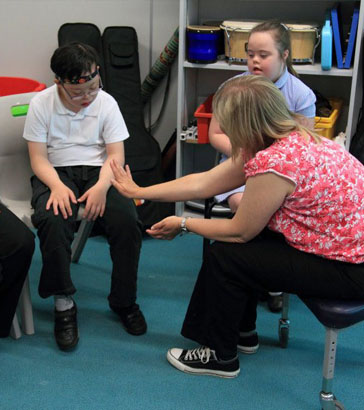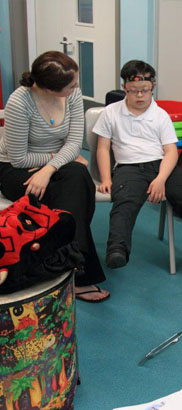
Team Around the Child (TAC)
is 'an individualised and evolving team of the few practitioners who see
the child and family on a regular basis to provide practical, co-ordinated
support in education, therapy and treatment'.
Its purpose is to provide a more co-ordinated, thorough and consistent approach
to supporting a child and their family.
Adapted from Limbrick, P. (2004) Early Support for Children with Complex
Needs: Team Around the Child and the Multi-agency Keyworker. Worcestershire:
Interconnections.

There are three essential features of TAC:
- Each TAC has a multi-professional membership bringing together the practitioners who support the child and family regardless of their field of work or the agency they work for. This can include health, education, social services and the voluntary and private sectors.
- Each TAC empowers parents by offering them a full place in the team.
- Each TAC is led by a team leader who functions as the keyworker for the child and family with a very clearly defined and limited role. They also act as the main facilitator of the TAC.
For further information, visit the Team Around the Child interconnections site.
As a preliminary guide for anyone adopting the TAC approach, here are some essential features:
- The TAC approach is appropriate when children, young people and their families will get more effective support if people around them work together rather than separately.
- Children or young people and parents are members of their TAC and are fully involved in all decisions about support.
- Each child or young person's TAC becomes the small organisational nucleus for the bigger group of people involved.
- Support is based on helping relationships and genuine partnership.
- Support is joined up regardless of how many practitioners, services and agencies are involved.
- Each TAC agrees a single, unified, multi-agency action plan.
- Each TAC is led by a TAC facilitator who functions as the multi-agency keyworker or lead professional with a very clearly defined and limited role.
- Each TAC aspires to provide a creative, imaginative and resourceful response to needs.
I am thrilled by the Key Worker Project. It would have been valuable
earlier. In the first year [after my child was born], we had numerous
professionals, a fragmented service and conflicting advice. The first
[TAC] meeting was so useful;
we ironed out different approaches and agreed clear, consistent objectives.
A parent quoted in Wellings, 2005
The TAC approach can be used with school-aged children and teenagers who have
a variety of needs, short term or ongoing (Limbrick, 2001). It is most suitable for use with pre-school infants requiring
early intervention support and children and young people with multiple or complex needs, who require input from practitioners
from several professions (Limbrick, 2001). This may be soon after a diagnosis, whether at an early age, or receiving diagnosis
when school-aged.
To find out more about the TAC model and approach, visit the Team Around the Child interconnections site 'wider TAC approach' page.

The TAC model provides an ideal forum for discussion and negotiation of attitudes, approaches and aspirations. The TAC is a meeting of equals, people who have different expertise and roles but who share sincere concern for the well-being of the child and family. It is important that TAC meetings are carefully managed so parents have a genuinely equal voice amongst the professionals. To achieve this:
- TAC relationships must be based on empathy, respect, honesty and trust.
- Parents should not feel patronised.
- TAC members should not pretend to listen and then ignore parents' points afterwards.
- Parents' concerns should not be dismissed by labelling them as neurotic, over-anxious, awkward, too demanding, or in denial.

Department for Education (2011) Team around the child( TAC).
Limbrick, P. (2001) The Team Around the Child – Multi-agency Service Co-ordination for Children with Complex Needs and Their Families: A manual for service development, Worcestershire: Interconnections.
Limbrick, P. (2004) Early Support for Children with Complex Needs: Team Around the Child and the Multi-agency Keyworker, Worcestershire: Interconnections.
Limbrick, P. (2009) TAC for the 21st Century: Nine Essays on Team Around the Child, Clifford: Interconnections.
Wellings, J. (2005) Team-around-the-child and the key working approach: TAC practice in Wolverhampton, PMLD-Link, 17 (2), 17-19.